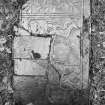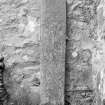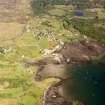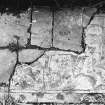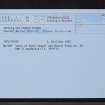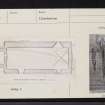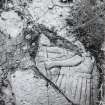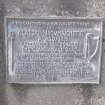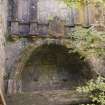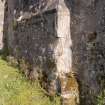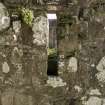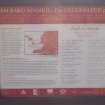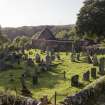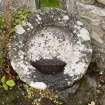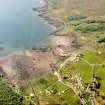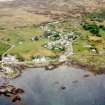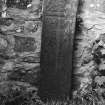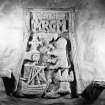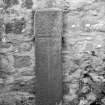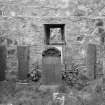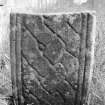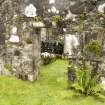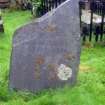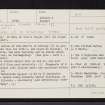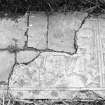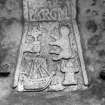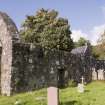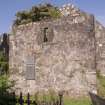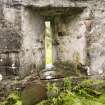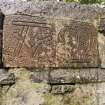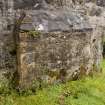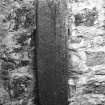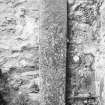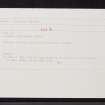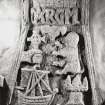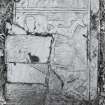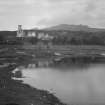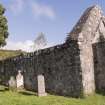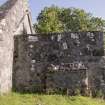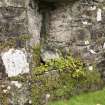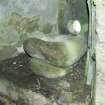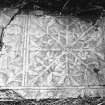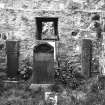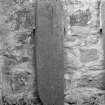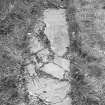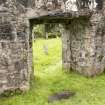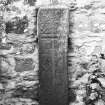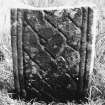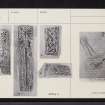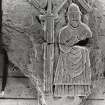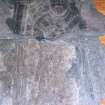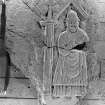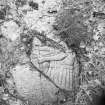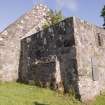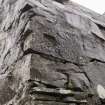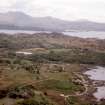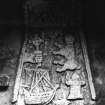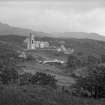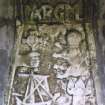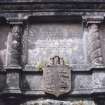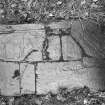Arisaig, Old Parish Church
Armorial Panel (17th Century), Burial Ground (Medieval), Church (16th Century), Font (Medieval)(Possible), Grave Slab(S) (Medieval), Gravestone (18th Century)
Site Name Arisaig, Old Parish Church
Classification Armorial Panel (17th Century), Burial Ground (Medieval), Church (16th Century), Font (Medieval)(Possible), Grave Slab(S) (Medieval), Gravestone (18th Century)
Alternative Name(s) Arisaig Village, Old Church And Burial Ground; St Maelrubha's Church
Canmore ID 22520
Site Number NM68NE 1
NGR NM 65887 86916
Datum OSGB36 - NGR
Permalink http://canmore.org.uk/site/22520
- Council Highland
- Parish Arisaig And Moidart
- Former Region Highland
- Former District Lochaber
- Former County Inverness-shire
Kilmory Church, early 16th century Cement capped ruin of church dedicated to St. Maelrubha and probably built by the warlike Eoin Muideartach (John of Moidart), 8th Chief of Clanranald, who died in 1584 having erected a similar church at Kildonnan in Eigg. Opposite a low doorway in the burial enclosure attached to the west end is an arched tomb recess, now mounted with a Clanranald armorial panel dated 1641 , one of an important group of carved stones (see also Kildonnan, Eigg and Howmore, South Uist). Above is an unexpectedly grand monument of 1843 to the wife and children of Maj. Simon Macdonald of Morar -late 17th-century Renaissance style with twisted columns. Within the church ruin and graveyard lie some important 16th-century carved slate slabs and fragments, depicting a kilted archer, huntsman, animals, and foliated cross above a claymore. One panel of a religous figure (now kept on St. Mary's altar) was, until at least 1927, attached to a crucifixion scene, possibly part of a triptych. It has been suggested that this formed part of a carved memorial in the arched tomb recess, similar to the 16th-century Macleod tombs at Rodel, Harris, with whose carving it bears affinities. In what Philip Webb described as 'the rude little churchyard with its ancient ruins standing by', do not miss his robust Arts & Crafts gothic memorial cross, 1893, commissioned by the Astley sisters in memory of their parents, Francis D. P. and Gertrude Astley, and their brother, Francis.
Taken from "The Western Seaboard: An Illustrated Architectural Guide", by Mary Miers, 2008. Published by the Rutland Press http://www.rias.org.uk
Field Visit (19 May 1970)
The ruins of St Maelrubha's Chapel (Information from Monseigneur MacInnes, Chapel House, Morar) are as planned by Donaldson. Of the six inscribed stones only No. 2 and part of No. 1 were seen within the chapel at the time of investigation. The graveyard is still in use.
Visited by OS (NKB) 19 May 1970.
Desk Based Assessment (1970)
NM68NE 1.00 65887 86916
NM68NE 1.01 NM 6588 8692 Building
For Burial ground see also NM68NE 34 65884 86903
(NM 6588 8691) St Mary of Iona's Chapel (NR)
(In ruins) Grave Yard (NAT).
OS 6" map, Inverness-shire, 2nd ed., (1902)
The ancient church of Cill Mha'ru or Kilmory (Scott 1918) is probably no later than the 16th century and might be earlier. It is in two parts, the main building and an annexe which may, or may not, be contemporary. The walls are intact except that on the E, and were skilfully built from poor materials (Donaldson 1923). Fragments of 6 sculptured stones are contained within the church (Blundell 1911).
The correct dedication appears to be to St Maelrubha (c.671), the church being formerly styled Kilmolroy, or Kilmaroy or Kilvorie - eventually (and erroneously) corrupted into 'Mary' (Reeves 1861).
Information from OS.
Sources: W Reeves 1862; F O Blundell 1911; A B Scott 1918; M E M Donaldson 1923
Field Visit (7 September 2017)
The medieval church and burial ground at Arisaig were recorded in order to provide comparison with the remains at Eilean Fhianain, Loch Shiel. The detailed description of Arisaig (see downloadable PDF, WP004742) includes the church, the burial aisle and monuments to the Macdonalds of Morar, the late medieval carved stones and a short note on the burial ground itself.
Visited by HES Survey and Recording (GFG, ATW) 7 September 2017













































































